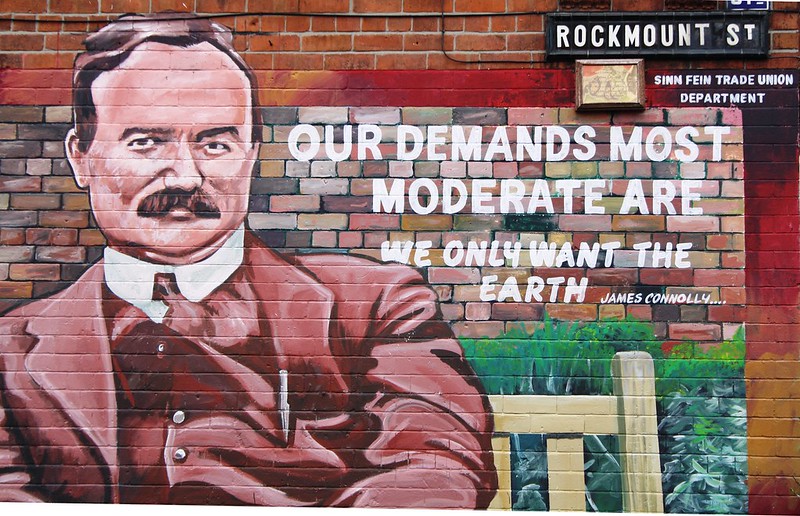Speaking of his time in Belfast, where he endeavored to organize Catholic and Protestant workers along principled, anti-imperialist lines, the Irish Marxist James Connolly was forced to concede that it sometimes felt as though he was promoting a “twentieth-century revolutionism amidst the mental atmosphere of the early seventeenth century.” Given the disturbing scenes beaming around the world of late—including the return of the most persistent visual export of Northern Ireland: petrol bombs hurtling over a wave of vicious sectarian rioting—you could be forgiven for concluding that this archaic atmosphere has survived well into the twenty-first century, as the region again appears to teeter along its centuries-old divide.

Sectarianism in Northern Ireland, however, cannot only be explained by reference to a set of lingering backward notions (something Connolly himself understood). Nor can it be wished away by simplistic and superficial efforts to locate it within a framework of cultural or religious enmity between Catholics and Protestants, with the warring tribes only kept apart by the civilizing intervention of crusading peacemakers like Tony Blair and the Clintons. If everyone is to blame, then no one is to blame.
The plague-on-both-your-houses approach favored by establishment politicians—including those within the British, United States, and Southern-Irish governments—conveniently omits the role of elites in creating and sustaining the circumstances that gave rise to a divided society, and the often violent intervention of imperialism that helped to sustain it. We were given a bitter reminder of this shameful legacy recently, as Boris Johnson offered up his painfully belated apology for the murder of ten innocent people by British paratroopers in the Ballymurphy massacre of August 1971 (five months before the same regiment mowed down 14 innocent people in Derry, “Bloody Sunday”).
“If [sectarian] relations have today been reduced to a squalid and protracted death in the back streets of Belfast,” as the liberal historian George Dangerfield once wrote, “it is because the Anglo-Irish past has not yet been put to rest.”1 Sectarianism, as Dangerfield’s quip ably suggests, is not only a body of reactionary ideas—it is a set of institutions, a particular form of political governance, and a peculiar but nevertheless indivisible form of class power, whose origins lie in the colonial subjugation of Ireland and the lasting effects of British imperial support for a partitioned island.
The great Irish Protestant revolutionary Wolfe Tone once described sectarianism as the “ghastly spectre of our distempered imagination.”2 His efforts to vanquish its ghoulish presence by uniting “Catholic, Protestant, and Dissenter” ultimately faltered against sustained efforts by British imperialism to re-conjure it for their own purposes. As the commander for mid-Ulster informed his superiors during Tone’s rebellion for independence in 1798:
I have arranged … to increase the animosity between the Orangemen and the United Irishmen. Upon that animosity depends the safety of the centre counties of the North.3
The sectarian card was played to great effect a century later when demands for an independent Ireland grew. As the rabid Tory Lord Randolph Churchill wrote:
I decided some time ago that if the G.O.M. went for Home Rule, the Orange card would be the one to play. Please God it may turn out the ace of trumps and not the two.4

And the device was used to great effect by capitalist elites too, amid growth of the Belfast trade union movement, with one British labour leader observing in 1912 that:
In Belfast you get Labour conditions the like of which you get in no other town[.] It is maintained by an exceedingly simple device … Whenever there is an attempt to root out sweating in Belfast the Orange big drum is beaten.
The creation of the Northern Ireland state a century ago (whose centenary celebration met with an embarrassing lack of enthusiasm, it should be noted, even from its most ardent proponents) did not reflect a pragmatic approach to managing conflicting national aspirations, but instead rested on the sustained and conscious application of divide-and-conquer tactics by establishment forces, leading to a victorious, counter-revolutionary wave that consolidated conservative regimes north and south, run in the interests of Irish capitalism and British imperial elites. The persistence of sectarian animosity today is not only an aftereffect of this troubled past, rather it is the living consequence of sectarianism being interwoven into the very fabric of the state at its foundation, a move Connolly presciently warned could only:
set back the wheels of progress[,] destroy the oncoming unity of the Irish Labour movement and paralyse all advanced movements whilst it endured.
These plain facts of Irish history are well known, even if they are regularly ignored by political elites in Ireland and abroad, in favor of a system of “calculated amnesia” that sanitizes sectarianism as little more than a localised pathology that drives its populace into blind hatred. This absolves the powerful forces on both sides of the sectarian divide that have a stake in maintaining a segregated society, rendering unto unionist elites the things that are unionist, and unto nationalists the things that are theirs. It also omits any culpability for the British state, which shares much of the responsibility for creating a divided society in the first place. Eradicating sectarianism in the North would require a radical move away from segregation—something polls suggest working-class people on both sides of the divide are desiring in increasing numbers—which in turn would require a massive state investment into new integrated schools, housing, and a full-frontal challenge to the sectarian forces who consider themselves gatekeepers of their communities. Neither local elites whose power rests on the communal divide, nor a tight-fisted Tory government in London, has shown any willingness to enact this kind of radical overhaul. Eliminating sectarianism requires billions, managing it costs next to nothing.
The French philosopher Badiou noted how a modern, capitalist state “always generates the existence of an imaginary object that is supposed to embody an identitarian ‘average,’” whose interests a state then purports to serve.5 In post-Belfast-Agreement Northern Ireland, this illusionary average is written into the very terms of governance, with all political decisions mediated through a system that allocates everything into the fixed categories of unionist, nationalist, or other, with the former two privileged above the latter in all political decisions. The Belfast Agreement was heralded as a new dawn in a post-conflict Ireland, but it was more aptly described by the British Marxist John Newsinger as the “reconstruction of bourgeois order in Northern Ireland,” with the old Orange State partially reconfigured to make space for sections of the nationalist and republican middle class. It does not suffice to say, therefore, that the Northern Ireland state has failed to challenge sectarianism. Rather, it is more appropriate to say the Northern Ireland state is sectarian at its core: the superstructural configuration of communalism in legal and political form.
This interdependence between sectarianism and the structures of the Northern state was keenly observed by longtime socialist Eamonn McCann at the time of the signing of the Belfast Agreement, when he warned that its system of institutionalised division would give rise to new forms of sectarian animosity rather than its gradual elimination, as was confidently predicted:
The allocation of the entire population into separate sectarian camps, and the institution of mechanisms for ensuring that all decisions are weighed to ensure sectarian balance, will make competition between the Catholic and Protestant communities the main dynamic for politics in the future.
It will be in the direct and compelling interest of the leaderships of nationalist and unionist parties to reinforce communal loyalty as the basis of political allegiance, and to present themselves as the most forthright and uncompromising advocates of their own community’s interests vis-a-vis the interests of “the other side”.6
“The possibility of abrasion at the interfaces generating new conflagration”, McCann’s critique concluded, “will be a permanent feature of the system.” More than two decades later, as the ghastly specter of sectarian rioting again returns to these same interfaces, who could deny the validity of this appraisal? When the Belfast Agreement was signed in 1998, a young adult could reasonably presume that their future would be better than the life led by their parents. Two decades later this mood of optimism is a distant memory, amid endemic poverty on both sides of the divide and a decade or more of austerity initiated by both local and London-based politicians. It is this deep well of alienation that loyalist paramilitaries have tapped into in recent months—combined with what the poet Tom Paulin once described as the “festering sense of grievance which is at the centre of the loyalist mentality”—by manufacturing a series of confrontations that gave working class Protestant youth an outlet for their frustrations, but that leaves them with little more than a misplaced belief that their lot can be improved by hurling stones at communities riven with the very same—if not worse—deprivation than theirs.7
James Connolly’s advice to socialists that “no good, but infinite evil, can come of truckling to [loyalism]” retains its power today. It must be combined with an understanding that in the absence of any kind of hope—without a class based movement, in other words, that can redirect workers anger toward the top of society—the meagre appeal of a loyalism built on the promise that “This we maintain,” as the old Orange adage put it, will continue to gain purchase. As Northern Ireland trudges into its centenary year and the much heralded promise of the Belfast Agreement unravels, the danger is that reactionary forces will further stoke tensions in the months ahead, especially in a context where working people begin to feel the full effects of the coming post-pandemic downturn.
But the paradox of Irish history is that the very same conditions that give rise to sectarianism are also those that hold the potential of creating resistance from below. The recent riots are tremendously concerning, but they are the first reflections of a wider decay of the Northern Ireland state. In this precarious context, with anger bubbling beneath the surface, resurgent sectarianism is one possibility—but the potential for class politics is a live possibility too. Building a movement that can redirect anger toward those at the top is the most urgent task for socialists. But this must be combined with sober assessment that so long as a sectarian state exists, powerful forces will always be gifted with the opportunity to re-polarize politics along sectarian lines. Only by undoing that sectarian state structure, can the ghastly specter be exorcised for good.
- George Dangerfield, The Damnable Question: A Study in Anglo-Irish Relations (1979), xv.↩︎
- Kevin Whelan, The Tree of Liberty: Radicalism, Catholicism and the Construction of Irish Identity 1760-1830 (1996), 101.↩︎
- Quoted in Liam De Paor, Divided Ulster (1970), 40.↩︎
- Ibid., 69.↩︎
- Alain Badiou, The Rebirth of History (2012), 73.↩︎
- Eamonn McCann, War and Peace in Northern Ireland (1998), 243.↩︎
- Quoted in Susan McKay, “Politicians must speak out against sectarian revival,” Irish Times (Sep 6, 2012).↩︎

